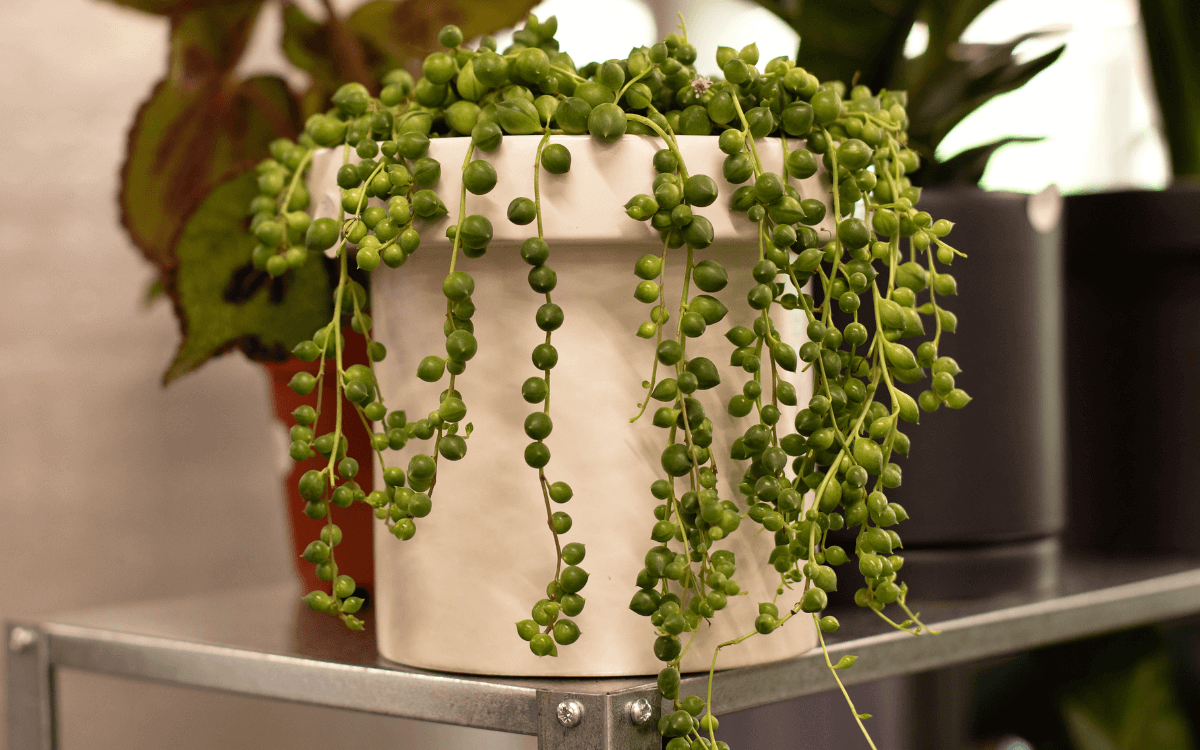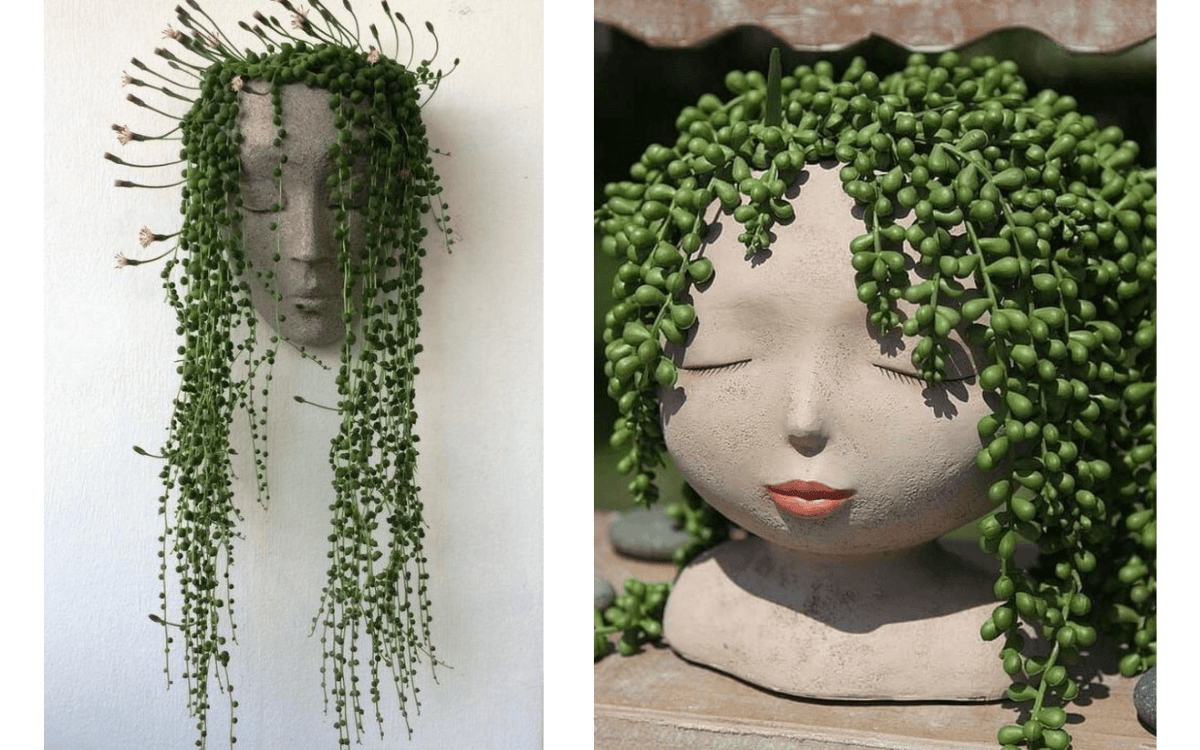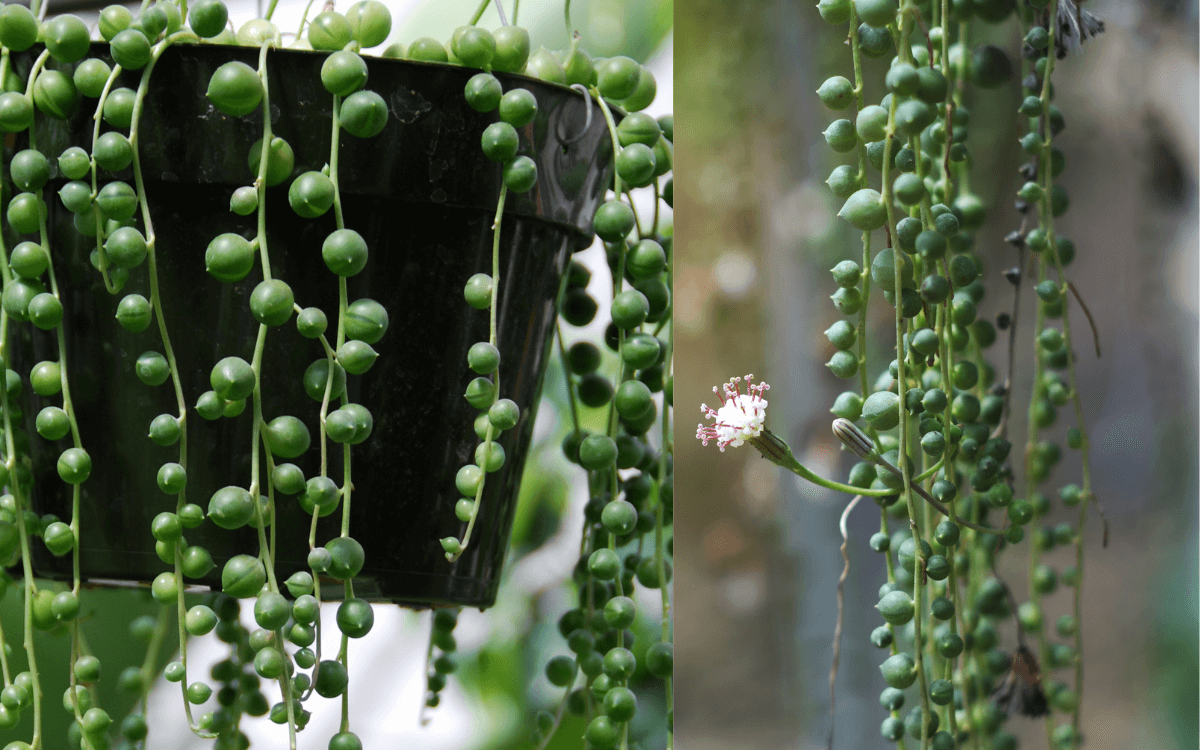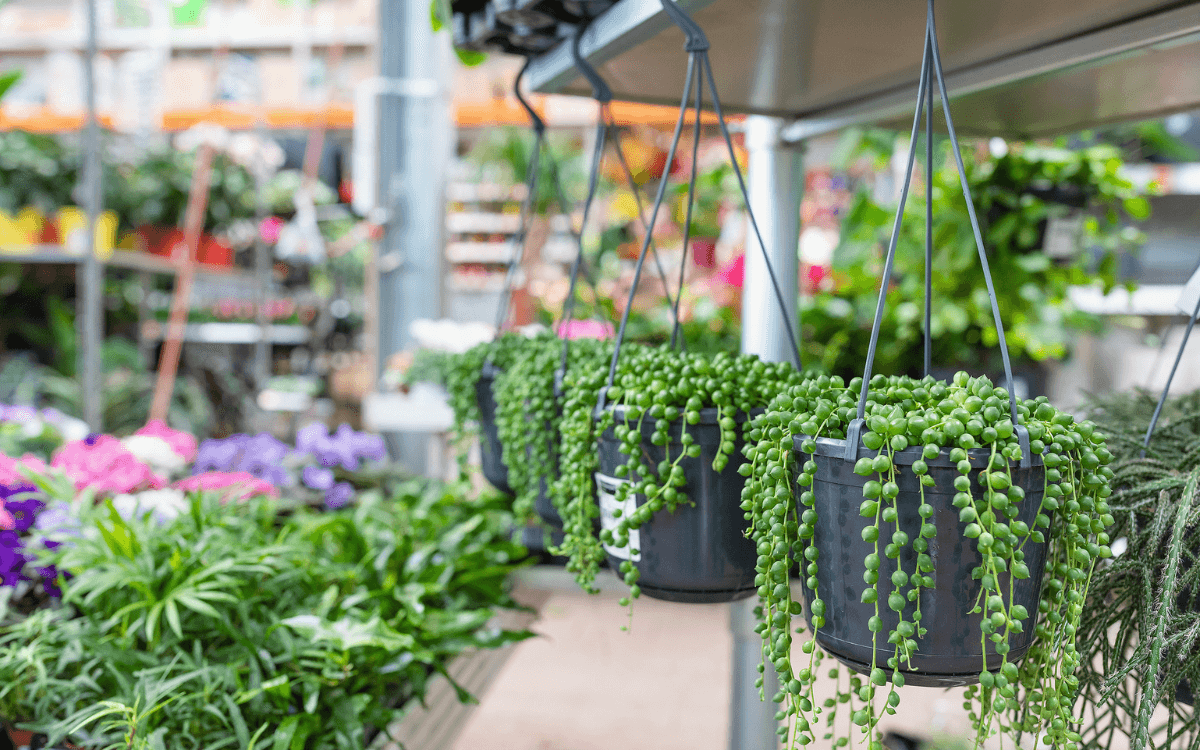The Senecio rowleyanus plant, better known as String of Pearls, is a true gem of the botanical world.
Highlighted for its unique appearance and easy cultivation, in this article you will learn more about the characteristics and cultivation of this plant.
Characteristics of the String of Pearls Plant
The first thing that catches the eye in this plant is its unmistakable appearance.
Its long, hanging stems are adorned by a sequence of spherical leaves, resembling small bright green pearls. These leaves are actually water reservoirs, an ingenious adaptation to survive in arid environments.
Originating from the African continent, this succulent easily adapts to various environments, showing incredible versatility from dry and sandy soils to locations with higher humidity.
With stems that can extend between 60 cm (23.6 inches) to 1 meter (3.28 feet), the String of Pearls plant is perfect for hanging pots or for use as a climbing plant.
Below are more characteristics and curiosities about this plant:
- The plant produces white and delicate flowers in the spring, with purple stamens that contrast with the petals and have a soft scent similar to cinnamon.
- Care should be taken to keep it out of reach of children and pets, as this is a toxic plant.
- It is widely used in interior decoration, especially when placed in hanging baskets, where its stems can fall freely, creating a stunning visual effect.
- Despite its African roots, the plant has found a home in various parts of the world, such as Mexico and Panama, adapting well to different climates.
See below how to properly care for this plant.
How to Care for the String of Pearls Plant
Senecio rowleyanus or Curio rowleyanus is a succulent considered easy to cultivate, ideal for gardening beginners.
See below the necessary care to keep this plant beautiful and healthy.
Where to Plant
The hanging nature of the String of Pearls makes it ideal to be displayed in hanging pots. These pots can be placed in:
- Balconies
- Window sills
- Inside the house
It is important that its stems can fall freely, creating a stunning visual effect.
If you choose to have the plant inside your house, choose a location near a window that receives plenty of natural light, but without direct sunlight. East or west-facing windows are often ideal, offering soft light that favors healthy plant growth.
Ideal Climate for the String of Pearls Plant
This plant prefers well-lit environments, but without direct exposure to strong sunlight, which can burn its delicate leaves.
A location with filtered or indirect sunlight is ideal, providing the perfect balance between light and protection.
The String of Pearls is a plant that loves warmth, flourishing in climates that mimic its natural tropical and dry habitat.
It thrives best in temperatures that remain between 16°C (60.8°F) and 25°C (77°F). It is crucial to protect it from cold conditions, as it is vulnerable to temperatures below 10°C (50°F), which can cause damage or even prevent survival in extreme cold.
Furthermore, it prefers environments with low humidity, making good air circulation important to prevent moisture stagnation.
However, caution is needed with very strong drafts, which can lead to rapid dehydration of the leaves.
Extra tips:
- If necessary, use curtains or shading to filter direct sunlight during the hottest hours, thus protecting the plant from potential damage.
- Be alert to signs of stress in the plant, such as discolored or fallen leaves, which may indicate that the climatic conditions are not suitable.
- Places with constant shade, high humidity, or prolonged exposure to the sun are not suitable for the String of Pearls. Such exaggerated conditions can lead to health problems for the plant, including sunburn or rot.
Ideal Soil for the String of Pearls Plant
The most critical aspect for the soil of the String of Pearls is efficient drainage. A soil that retains excessive water can lead to root rot, a fatal problem for many succulents.
A slightly sandy soil is perfect for this plant. The sand improves drainage and prevents moisture buildup, creating a healthy underground environment for the roots.
Although drainage is essential, the soil must also be nutritious.
Adding organic matter, such as worm humus, can enrich the soil, providing the necessary nutrients for plant growth.
To ensure the ideal mix of drainage and nutrients, consider using commercial substrates specifically formulated for succulents and cacti. These substrates are designed to mimic the ideal growing conditions for these plants.
A layer of gravel at the bottom of the pot can further improve drainage.
Watering should be carefully monitored to ensure that the soil remains moist, but never waterlogged. Allowing the soil to dry between watering is a healthy practice.
Recommended readings:
- Monkey Tail Cactus: How to Care and Propagate
- How to Plant, Grow and Care for Celosia (Step by Step)
- Ixora – A Beautiful Plant to Color Your Garden
- Ludisia the Jewel Orchid – How to Care in 7 Simple Steps
- Oncidium (Dancing-lady Orchid) – How to Care in 9 Steps
- How to Care for Ferns in 9 Steps (For Beginners)
Ideal Fertilization – Senecio rowleyanus
Considering that Senecio rowleyanus is a succulent, it requires fewer nutrients compared to other plants. In well-prepared and suitable soils, the need for additional fertilization is minimal.
The ideal periods for fertilization are in the spring and summer, when the plant is in its active growth stage, absorbing nutrients more efficiently.
Prefer organic fertilizers, which are less likely to cause damage from excess nutrients. Worm humus is an excellent choice, providing a rich source of nutrients in a balanced and gentle manner.
It is important to select fertilizers with a low nitrogen content to avoid excessive growth and plant fragility, which can result from high concentrations of this nutrient.
If it is necessary to complement the nutrition, opt for fertilizers formulated especially for succulents.
These products are generally less concentrated and suitable for the specific needs of succulents, including the String of Pearls.
Planting, Repotting, and Propagation
To plant this species, follow the steps below:
- Soil and Pot Preparation: Choose a specific substrate for succulents that promotes excellent drainage, and use pots with holes at the bottom to prevent water accumulation. A layer of gravel or perlite at the bottom of the pot can further improve drainage.
- Planting Method: When planting, carefully position the seedlings in the substrate, avoiding compacting the soil around them, so as not to hinder air circulation around the roots. The lightness of the soil is essential for the healthy development of the roots.
- Initial Watering: After planting, water the plant moderately to moisten the substrate, but be careful not to saturate, as Senecio rowleyanus is sensitive to excess water.
Repotting should be considered when the pot becomes too small for the plant or the substrate loses its drainage and nutrition properties.
Normally, this occurs every 2 to 3 years.
When repotting, choose a slightly larger pot and completely renew the substrate to revitalize the plant’s environment.
Check the roots during the process, removing any damaged or rotten parts.
You can propagate your String of Pearls plant through cuttings.
- Propagation by Cuttings: Cut sections of about 10 cm and let them dry in the air for a few hours or days, so that the cut forms a protective film.
- Planting Cuttings: Remove the leaves near the cut and plant the cuttings in a mix of sand and succulent substrate. This mixture promotes drainage and facilitates the development of new roots.
- Post-Planting Care: Keep the seedlings in a well-lit place, but protected from direct sun, and water sparingly, just enough to keep the substrate slightly moist.
- Note: It is common for stems to naturally detach from the main plant; these can be replanted directly into moist substrate to form new plants.
Pests, Diseases, and Other Problems that May Affect the String of Pearls Plant
The most common pests that can attack this plant are:
- Aphids
- Scale insects
- Mites
Regular cleaning of the leaves with a mild solution of water and neutral soap can help prevent infestations.
In more severe cases, the use of specific insecticides, always following the manufacturer’s instructions, may be necessary.
Regarding diseases and other problems that may appear in your plant, below are the most common:
- Root Rot: This is a common condition caused by excess moisture in the soil, which can be prevented by ensuring proper drainage and regulating watering.
- Powdery Mildew: Appears as a white fungal layer on the leaves. The best prevention is to maintain an environment with good air circulation and adequate light, avoiding excessively humid environments.
- Leaf Drop: Various factors can cause the “pearls” to drop, such as drafts, excess direct light, nutritional deficiency, or inadequate watering. Adjusting the cultivation conditions usually solves the problem.
- Leaf Loss: Abrupt changes in the environment, such as temperature variations, drafts, or direct exposure to the sun, can lead to the loss of characteristic leaves. Avoiding such extremes is crucial for the health of the plant.
- Excess Fertilizers: Fertilization should be done cautiously. Excessive use of fertilizers can overload the plant with nutrients, leading to leaf drop or even root rot.
This was our complete guide on the characteristics, curiosities, and how to care for the String of Pearls plant.
If you have any questions or would like to share your story with this plant, leave a comment below and, if you liked this text, help us by sharing it on your social networks.
See you next time 😀







